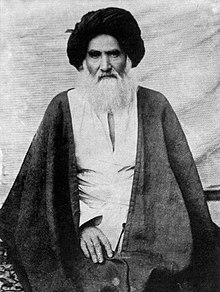| Grand Ayatollah SayyidAbu al-Hasan Isfahani | |
|---|---|
| ابوالحسن موسوی اصفهانی | |
 | |
| Personal life | |
| Born | 1861 (1861) Isfahan, Sublime State of Persia |
| Died | November 4, 1946(1946-11-04) (aged 84–85) Kadhimiya, Kingdom of Iraq |
| Nationality | Iranian |
| Religious life | |
| Religion | Islam |
| Jurisprudence | Twelver Shia Islam |
| Muslim leader | |
| Based in | Najaf, Iraq |
| Post | Grand Ayatollah |
| Period in office | 1937–1946 |
| Predecessor | Muhammad Hossein Naini |
| Successor | Hossein Borujerdi |
Grand Ayatollah Sayyid Abu al-Hasan Musawi Isfahani (Persian: ابوالحسن موسوی اصفهانی) (Arabic: أبوالحسن الموسوي الأصفهاني); 1861 – November 4, 1946) was an Iranian Shia marja'.
Isfahani became the leading marja' of the Shia world after the death of Muhammad-Hussein Naini.
Biography
Isfahani was born in Madiseh to Sayyid Muhammad Isfahani, a renowned alim of Isfahan.
Isfahani passed his preliminary training in Nimarud School in Isfahan and travelled to Najaf in 1890. He joined the lessons of Akhund Khorasani, who soon recognized the talents of his disciple. Isfahani received his degree of Ijtihad from Khorasani. After the death of his contemporary scholar, Ayatollah Mirza Hussein Naini, he became the sole Marja' for most of Shia Muslims. Isfahani was banished to Iran for protecting Iraqi Muslims against colonial policies. Also, he had a strong position about the incidents at the Goharshad Mosque in Mashhad.
Isfahani had a grandson named Musa Musawi who studied with him for 17 years. Musa Musawi was a renowned academic and philosopher, who wrote a revisionist text on Shia Islam where he sought to purify schism from innovation and bring it closer to the majority of Muslims.
Works
In Fiqh, Wasila al-Naja which due to its comprehensive nature, has been elucidated by many Fuqaha including Ruhollah Khomeini.
Students
- Musa Musawi
- Ayatollah Borqei
- Muhsin al-Hakim
- Mohammad Hadi Milani
- Mirza Hashem Amoli
- Muhammad Husayn Tabataba'i
- Mohammad-Taqi Bahjat Foumani
- Sayyed Hassan Musavi Bojnourdi
- Ali Naqi Naqvi
Death
He died in Kadhimiya in 1946.
See also
References
- ^ Rainer Brunner; Werner Ende (1 January 2001). The Twelver Shia in Modern Times: Religious Culture and Political History. BRILL. p. 178. ISBN 90-04-11803-9.
- ^ Jibouri, Yasin (2005). Uswat Al-Aarifeen: A Look at the Life of Ayatullah Bahjat. Beirut, Lebanon: Al-Kharsan Foundation for Publications.
- ^ "Ayatullah al-Uzma Sayyid Abul Hasan Isfahani". imamreza.net. Archived from the original on 3 March 2016. Retrieved 4 April 2016.